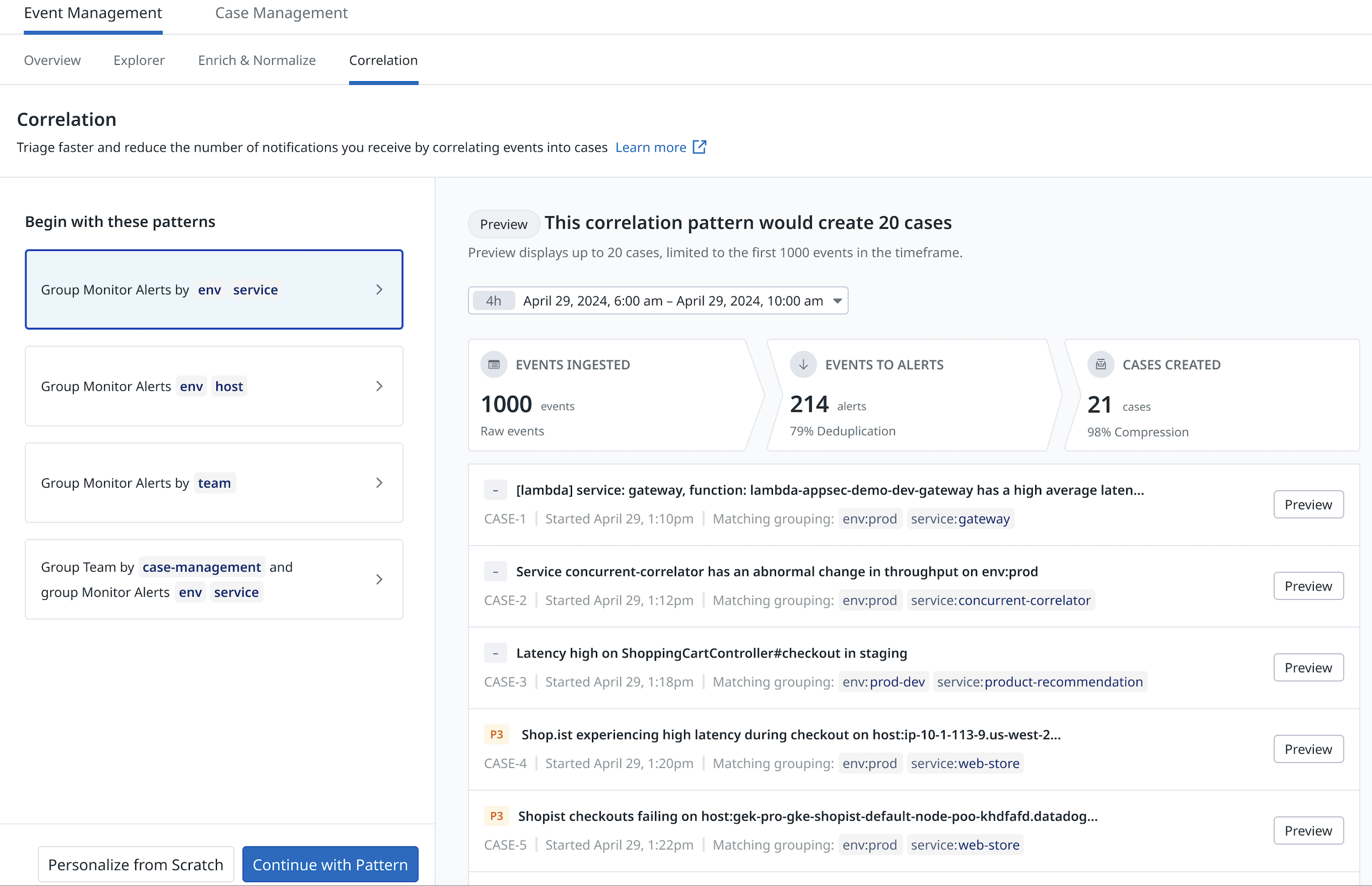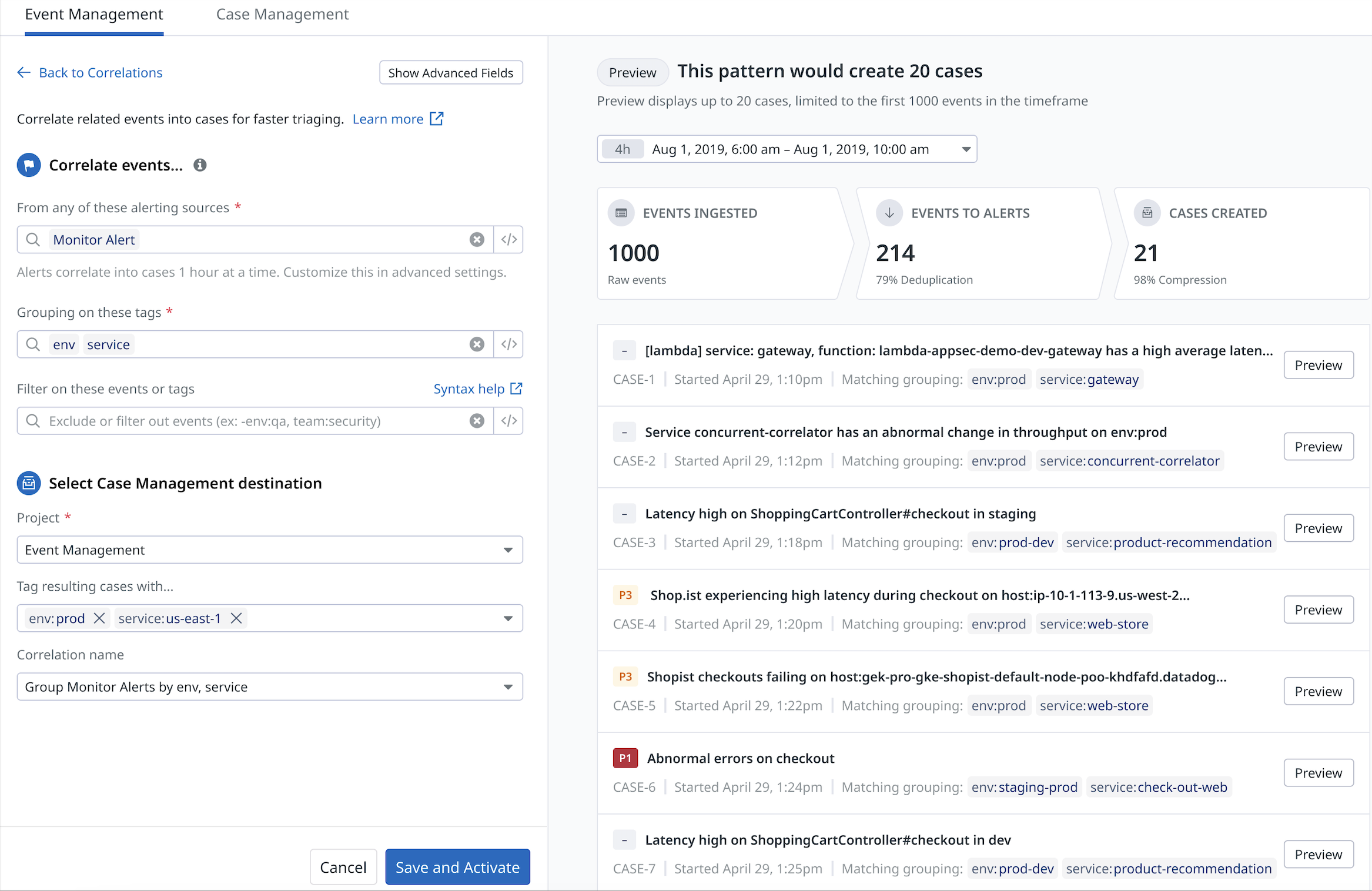- Esenciales
- Empezando
- Datadog
- Sitio web de Datadog
- DevSecOps
- Serverless para Lambda AWS
- Agent
- Integraciones
- Contenedores
- Dashboards
- Monitores
- Logs
- Rastreo de APM
- Generador de perfiles
- Etiquetas (tags)
- API
- Catálogo de servicios
- Session Replay
- Continuous Testing
- Monitorización Synthetic
- Gestión de incidencias
- Monitorización de bases de datos
- Cloud Security Management
- Cloud SIEM
- Application Security Management
- Workflow Automation
- CI Visibility
- Test Visibility
- Intelligent Test Runner
- Análisis de código
- Centro de aprendizaje
- Compatibilidad
- Glosario
- Atributos estándar
- Guías
- Agent
- Uso básico del Agent
- Arquitectura
- IoT
- Plataformas compatibles
- Recopilación de logs
- Configuración
- Configuración remota
- Automatización de flotas
- Actualizar el Agent
- Solucionar problemas
- Detección de nombres de host en contenedores
- Modo de depuración
- Flare del Agent
- Estado del check del Agent
- Problemas de NTP
- Problemas de permisos
- Problemas de integraciones
- Problemas del sitio
- Problemas de Autodiscovery
- Problemas de contenedores de Windows
- Configuración del tiempo de ejecución del Agent
- Consumo elevado de memoria o CPU
- Guías
- Seguridad de datos
- Integraciones
- OpenTelemetry
- Desarrolladores
- Autorización
- DogStatsD
- Checks personalizados
- Integraciones
- Crear una integración basada en el Agent
- Crear una integración API
- Crear un pipeline de logs
- Referencia de activos de integración
- Crear una oferta de mercado
- Crear un cuadro
- Crear un dashboard de integración
- Crear un monitor recomendado
- Crear una regla de detección Cloud SIEM
- OAuth para integraciones
- Instalar la herramienta de desarrollo de integraciones del Agente
- Checks de servicio
- Complementos de IDE
- Comunidad
- Guías
- API
- Aplicación móvil de Datadog
- CoScreen
- Cloudcraft
- En la aplicación
- Dashboards
- Notebooks
- Editor DDSQL
- Hojas
- Monitores y alertas
- Infraestructura
- Métricas
- Watchdog
- Bits AI
- Catálogo de servicios
- Catálogo de APIs
- Error Tracking
- Gestión de servicios
- Objetivos de nivel de servicio (SLOs)
- Gestión de incidentes
- De guardia
- Gestión de eventos
- Gestión de casos
- Workflow Automation
- App Builder
- Infraestructura
- Universal Service Monitoring
- Contenedores
- Serverless
- Monitorización de red
- Coste de la nube
- Rendimiento de las aplicaciones
- APM
- Términos y conceptos de APM
- Instrumentación de aplicación
- Recopilación de métricas de APM
- Configuración de pipelines de trazas
- Correlacionar trazas (traces) y otros datos de telemetría
- Trace Explorer
- Observabilidad del servicio
- Instrumentación dinámica
- Error Tracking
- Seguridad de los datos
- Guías
- Solucionar problemas
- Continuous Profiler
- Database Monitoring
- Gastos generales de integración del Agent
- Arquitecturas de configuración
- Configuración de Postgres
- Configuración de MySQL
- Configuración de SQL Server
- Configuración de Oracle
- Configuración de MongoDB
- Conexión de DBM y trazas
- Datos recopilados
- Explorar hosts de bases de datos
- Explorar métricas de consultas
- Explorar ejemplos de consulta
- Solucionar problemas
- Guías
- Data Streams Monitoring
- Data Jobs Monitoring
- Experiencia digital
- Real User Monitoring
- Monitorización del navegador
- Configuración
- Configuración avanzada
- Datos recopilados
- Monitorización del rendimiento de páginas
- Monitorización de signos vitales de rendimiento
- Monitorización del rendimiento de recursos
- Recopilación de errores del navegador
- Rastrear las acciones de los usuarios
- Señales de frustración
- Error Tracking
- Solucionar problemas
- Monitorización de móviles y TV
- Plataforma
- Session Replay
- Exploración de datos de RUM
- Feature Flag Tracking
- Error Tracking
- Guías
- Seguridad de los datos
- Monitorización del navegador
- Análisis de productos
- Pruebas y monitorización de Synthetics
- Continuous Testing
- Entrega de software
- CI Visibility
- CD Visibility
- Test Visibility
- Configuración
- Tests en contenedores
- Búsqueda y gestión
- Explorador
- Monitores
- Flujos de trabajo de desarrolladores
- Cobertura de código
- Instrumentar tests de navegador con RUM
- Instrumentar tests de Swift con RUM
- Detección temprana de defectos
- Reintentos automáticos de tests
- Correlacionar logs y tests
- Guías
- Solucionar problemas
- Intelligent Test Runner
- Code Analysis
- Quality Gates
- Métricas de DORA
- Seguridad
- Información general de seguridad
- Cloud SIEM
- Cloud Security Management
- Application Security Management
- Observabilidad de la IA
- Log Management
- Observability Pipelines
- Gestión de logs
- Administración
- Gestión de cuentas
- Seguridad de los datos
- Sensitive Data Scanner
- Ayuda
Pattern-based Correlation
This page is not yet available in Spanish. We are working on its translation.
If you have any questions or feedback about our current translation project, feel free to reach out to us!
If you have any questions or feedback about our current translation project, feel free to reach out to us!
To get you started, Datadog automatically suggests pattern-based correlations according to your environment. Click any of the recommendations to open the configuration for the recommended pattern. Configuration fields are pre-populated.
Create a pattern
To create a pattern:
- Navigate to Correlation.
- Click + Add a Pattern, at the top of the Pattern table. This opens a pattern configuration page that displays out-of-the-box suggested patterns on the left side, and a pattern output preview on the right side.
- You can adjust a suggested pattern by clicking + Continue With Pattern. This takes you to the pre-populated configuration page for additional tuning. Or, you can choose to create your own pattern by clicking + Personalize From Scratch
First, events are deduplicated to alert based on event aggregation key. Then, alerts are correlated to a case based on configuration.
For more information on how to sends events with aggregation key, see send events to datadog. Events without an aggregation key are deduped to one single alert within the timeframe.Suggested patterns
Suggested patterns are recommended based on your commonly used service and environment tags to help you get started with event correlation quickly.
Configuration
From the correlation configuration page
- Select the event source you want to group on from the dropdown.
- Define the grouping tags. Grouping tags are event facets. See the advanced settings section below if you don’t see the tag from the dropdown. Note: you can create facets on both event attribute and tag. To learn more, see the facets documentation.
- To exclude any events from the source defined above, add an event query in Filter by these events or tags to filter them out
Advanced settings (optional)
Click Show Advanced Settings.
You can add non-alerting sources and add grouping tags to correlate events.
- Non-alerting source
- is any event that is available in your Event Explorer as an event, but does not have an associated monitor or alert.
- Add grouping tags
- to add new grouping tags, this is same as adding new event facet.
Under Advanced correlation logic, you can specify the minimum number of correlated events it takes to create a case and update the timeframe.
Timeframe explanation
Correlate alerts to a case for : The max duration that net new alerts will be added to a case
Deduplicate events for those alerts for : The max duration for current alerts which have been correlated, but continue to flap or have not resolved. Events are deduped to the corresponding alert in the existing case before opening a new case
Preview pattern output
Preview the possible patterns and cases your configuration would potentially create. The preview panel displays
- the total number of ingested events(limit to the first 1000 events).
- the number of alerts that would be deduped from events.
- the number of cases that would be created based on the configuration.
Use this data to preview the impact of your correlations and understand the expected output of a pattern.
Notes: the default title in the preview case is the first alert in correlation. After you save a pattern, the event management case title is intelligently generated.
Select a Case Management destination
- From the Project dropdown menu, select from an existing Case to send your grouped events to.
- (Optional) Add a tag to resulting cases.
- Click Save and Activate to activate this pattern and group events into cases.
Update existing pattern
After you update an existing pattern, all live cases will stop processing. New events that match the pattern will create a new case.
Further Reading
Más enlaces, artículos y documentación útiles:


